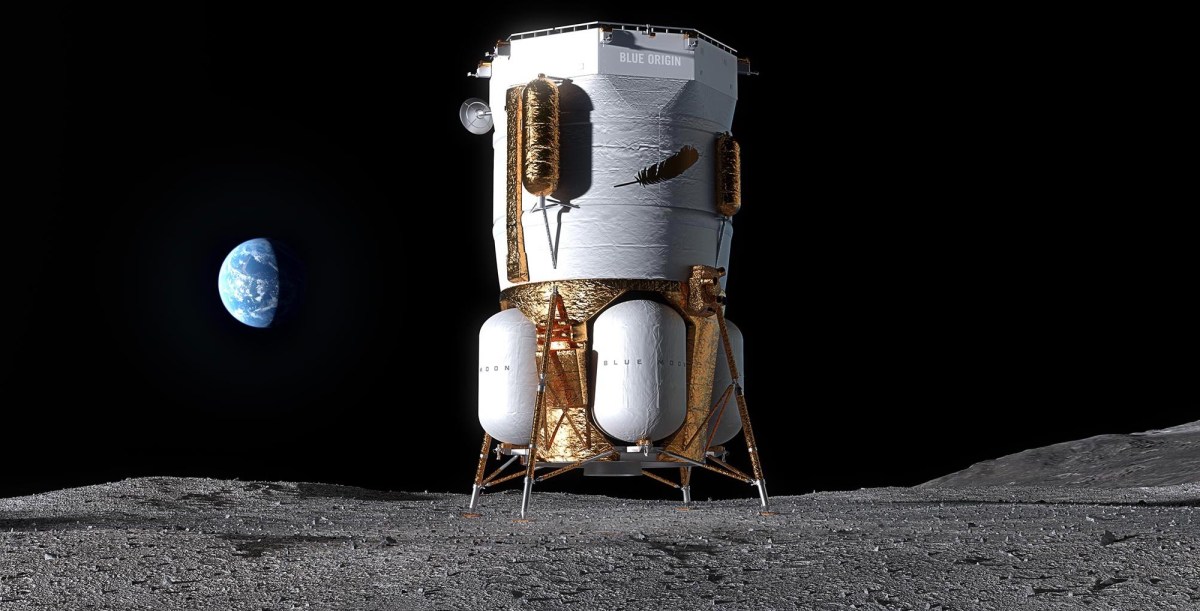WASHINGTON — A NASA payload will hitch a ride to the moon on Blue Origin’s first lunar lander mission, scheduled to launch as soon as next March.
In an Aug. 6 procurement filing, NASA revealed it selected Blue Origin to fly a camera system to study how engine plumes interact with regolith at south polar regions of the moon, collecting data to support future crewed landing missions. The payload, called Stereo Cameras for Lunar Plume Surface Studies (SCALPSS), will fly through NASA’s Commercial Lunar Payload Services (CLPS) program.
One copy of SCALPSS was sent to the moon on the first Intuitive Machines lander mission in February, collecting limited data. A second copy of SCALPSS will fly on Firefly Aerospace’s Blue Ghost lander, scheduled to launch late this year. However, NASA says it needs to fly SCALPSS on a lander with engines capable of producing at least 8,000 pounds-force (lbf) of thrust.
“The ability to obtain and analyze data from the plume/surface interaction involving engines with thrust levels in excess of 8,000 lbf of thrust is a necessary, and important, precursor to NASA’s future Artemis missions and, because of the strong correlation between interactions and thrust levels, the SCALPSS payload must be integrated on a lander having engines with thrust levels in excess of 8,000 lbf,” the NASA document states.
NASA concluded that the only commercial lander mission going to the lunar south pole that meets that thrust requirement from Blue Origin. While the thrust level that the lander provides is redacted in the document, the company has stated that the BE-7 engine it developed for the lander is capable of producing up to 10,000 pounds-force of thrust.
“Blue Origin is the only vendor conducting a commercial mission to the Lunar South Pole that meets NASA’s requirements with a thruster baseline level of [redacted] Ibf. This commercial mission is for Blue Origin’s [redacted] Mark 1 Serial Number 1 lander,” the NASA document states. While the document redacted the name of the lander, Blue Origin has publicized a “Pathfinder” mission for its initial robotic version of its Blue Moon lander, designated “MK1-SN001”, it plans to fly as a demonstration mission.
The NASA document is called a “Justification for an Exception to Fair Opportunity” and explains why it is awarding a task order to Blue Origin without a competition. That task order, called CT-3, has not been publicized by either NASA or Blue Origin and does not appear on a NASA list of current and future CLPS task orders.
Besides the thrust level, NASA justified giving Blue Origin the task order, valued at $6.1 million, because the company plans to launch the mission in 2025. (The exact date of the launch is redacted.) “To inform Artemis’ first mission, and allow for any necessary changes, SCALPSS must be delivered to the Lunar surface by the end of calendar year 2025,” the agency stated.
In an Aug. 1 application to the Federal Communications Commission, Blue Origin provided other details about the Blue Moon Pathfinder mission. The company said the mission is scheduled to launch as soon as March 2025 on its New Glenn rocket. The company had previously disclosed flying the Pathfinder mission in 2025.
“Blue Moon MK1 Pathfinder is a single-launch, lunar cargo lander that will land on the lunar surface and pave the way for safe, reliable, and affordable access to the lunar environment,” the company stated, and “will prove out critical systems for future Blue Moon missions.”
New Glenn will place Blue Moon into low Earth orbit, remaining there for three to four orbits to do initial checkouts. It will then raise its apogee for additional tests, including of its high-gain antenna system, before performing a translunar injection maneuver to go to the moon, entering a low lunar orbit five to seven days later. The spacecraft will conduct “multiple subsystem characterization activities” in lunar orbit before attempting a landing.
“Blue Moon MK1 Pathfinder will host a suite of sensors and cameras. The equipment will help hone space flight skills needed for the ambitious future Blue Origin is planning in the years to come by providing environmental data and imaging for future missions,” the company said in its FCC filing, which did not mention specifically the NASA SCALPSS payload.
The FCC filing also illustrates the size of Blue Moon, which even in its Mark 1 version is far larger than other commercial lunar landers. The spacecraft is 8.05 meters tall with a diameter of 3.08 meters. The spacecraft has a fully fueled, or wet, mass of up to 21,350 kilograms. The company previously said Blue Moon Mark 1 can deliver up to three tons of payload to the lunar surface.
The company says technologies developed for the Mark 1 version of Blue Moon will support work on the Mark 2 version, which is designed to carry astronauts to and from the lunar surface. NASA selected Blue Origin last year for a second Human Landing System (HLS) award to develop and demonstrate Blue Moon Mark 2 after the agency picked SpaceX’s Starship for the first HLS award in 2021.
